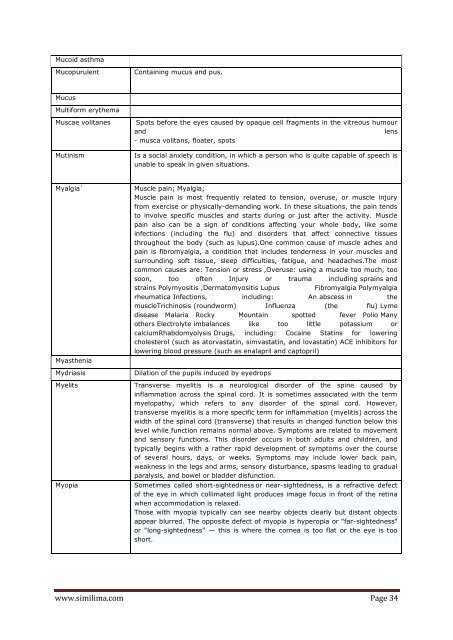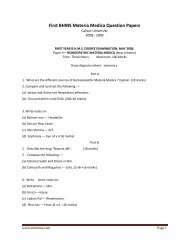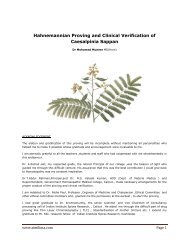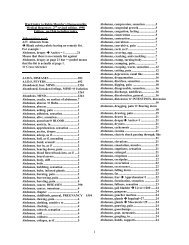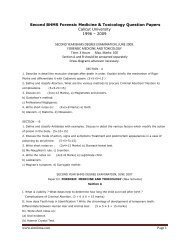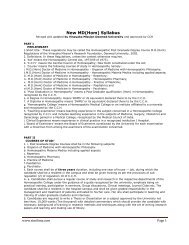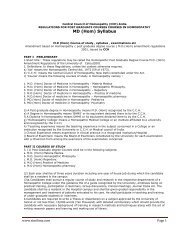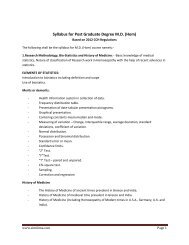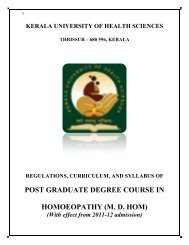Denotations & Old terminologies used in Homopathy - Similima
Denotations & Old terminologies used in Homopathy - Similima
Denotations & Old terminologies used in Homopathy - Similima
Create successful ePaper yourself
Turn your PDF publications into a flip-book with our unique Google optimized e-Paper software.
Mucoid asthma<br />
Mucopurulent Conta<strong>in</strong><strong>in</strong>g mucus and pus.<br />
Mucus<br />
Multiform erythema<br />
Muscae volitanes 1. Spots before the eyes ca<strong>used</strong> by opaque cell fragments <strong>in</strong> the vitreous humour<br />
and lens<br />
- musca volitans, floater, spots<br />
Mut<strong>in</strong>ism Is a social anxiety condition, <strong>in</strong> which a person who is quite capable of speech is<br />
unable to speak <strong>in</strong> given situations.<br />
Myalgia` Muscle pa<strong>in</strong>; Myalgia;<br />
Muscle pa<strong>in</strong> is most frequently related to tension, overuse, or muscle <strong>in</strong>jury<br />
from exercise or physically-demand<strong>in</strong>g work. In these situations, the pa<strong>in</strong> tends<br />
to <strong>in</strong>volve specific muscles and starts dur<strong>in</strong>g or just after the activity. Muscle<br />
pa<strong>in</strong> also can be a sign of conditions affect<strong>in</strong>g your whole body, like some<br />
<strong>in</strong>fections (<strong>in</strong>clud<strong>in</strong>g the flu) and disorders that affect connective tissues<br />
throughout the body (such as lupus).One common cause of muscle aches and<br />
pa<strong>in</strong> is fibromyalgia, a condition that <strong>in</strong>cludes tenderness <strong>in</strong> your muscles and<br />
surround<strong>in</strong>g soft tissue, sleep difficulties, fatigue, and headaches.The most<br />
common causes are: Tension or stress ,Overuse: us<strong>in</strong>g a muscle too much, too<br />
soon, too often Injury or trauma <strong>in</strong>clud<strong>in</strong>g spra<strong>in</strong>s and<br />
stra<strong>in</strong>s Polymyositis ,Dermatomyositis Lupus Fibromyalgia Polymyalgia<br />
rheumatica Infections, <strong>in</strong>clud<strong>in</strong>g: An abscess <strong>in</strong> the<br />
muscleTrich<strong>in</strong>osis (roundworm) Influenza (the flu) Lyme<br />
disease Malaria Rocky Mounta<strong>in</strong> spotted fever Polio Many<br />
others Electrolyte imbalances like too little potassium or<br />
calciumRhabdomyolysis Drugs, <strong>in</strong>clud<strong>in</strong>g: Coca<strong>in</strong>e Stat<strong>in</strong>s for lower<strong>in</strong>g<br />
cholesterol (such as atorvastat<strong>in</strong>, simvastat<strong>in</strong>, and lovastat<strong>in</strong>) ACE <strong>in</strong>hibitors for<br />
lower<strong>in</strong>g blood pressure (such as enalapril and captopril)<br />
Myasthenia<br />
Mydriasis Dilation of the pupils <strong>in</strong>duced by eyedrops<br />
Myelits Transverse myelitis is a neurological disorder of the sp<strong>in</strong>e ca<strong>used</strong> by<br />
<strong>in</strong>flammation across the sp<strong>in</strong>al cord. It is sometimes associated with the term<br />
myelopathy, which refers to any disorder of the sp<strong>in</strong>al cord. However,<br />
transverse myelitis is a more specific term for <strong>in</strong>flammation (myelitis) across the<br />
width of the sp<strong>in</strong>al cord (transverse) that results <strong>in</strong> changed function below this<br />
level while function rema<strong>in</strong>s normal above. Symptoms are related to movement<br />
and sensory functions. This disorder occurs <strong>in</strong> both adults and children, and<br />
typically beg<strong>in</strong>s with a rather rapid development of symptoms over the course<br />
of several hours, days, or weeks. Symptoms may <strong>in</strong>clude lower back pa<strong>in</strong>,<br />
weakness <strong>in</strong> the legs and arms, sensory disturbance, spasms lead<strong>in</strong>g to gradual<br />
paralysis, and bowel or bladder disfunction.<br />
Myopia Sometimes called short-sightedness or near-sightedness, is a refractive defect<br />
of the eye <strong>in</strong> which collimated light produces image focus <strong>in</strong> front of the ret<strong>in</strong>a<br />
when accommodation is relaxed.<br />
Those with myopia typically can see nearby objects clearly but distant objects<br />
appear blurred. The opposite defect of myopia is hyperopia or "far-sightedness"<br />
or "long-sightedness" — this is where the cornea is too flat or the eye is too<br />
short.<br />
www.similima.com Page 34


